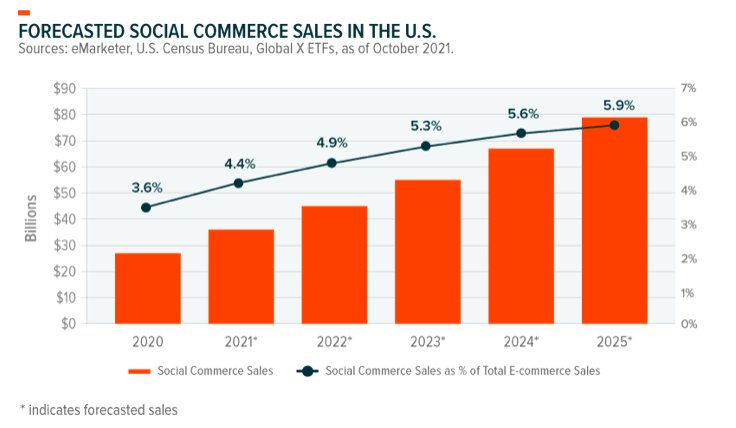By Pedro Palandrani, research analyst, Global X ETFs
User growth for many established social media platforms has been slowing for years as these internet giants are simply running out of non-users in their addressable markets. In order to fulfill high growth expectations, these networks pivoted their business strategies away from acquiring new users and instead towards maximizing the monetization of existing ones.
While the first stage of ARPU (average revenue per user) maximization centered around hyper-targeted advertising, more recent efforts center around social commerce: where social media and ecommerce intersect to offer shopping experiences that live directly within social media platforms.
This rapidly emerging trend is causing retailers to redouble their social media strategies and social media platforms to retool their apps around shopping features.
Social Commerce
Social commerce differs from traditional e-commerce because rather than shopping on dedicated e-commerce websites, it allows users to shop within the social media platforms that they use regularly. Such an approach reduces friction, allows users to digitally comment or consult with friends, and enables hyper-targeted advertising and custom shopping experiences.
Conversely, traditional e-commerce methods, like online stores, tend to be more brand or product-centric, with shoppers often navigating pages of dozens of products to find the goods they want.
Key Takeaways
- Brands are increasing their social media efforts and spend to meet customers where they spend their time.
- As social media websites gain commerce traction, increasing ARPU becomes a key metric to gauge success.
- Consumers swayed by the ease of a one-stop checkout process as opposed to traditional e-commerce methods.
Early Adopters
Social Commerce Enters the Early Adopters Phase
Traditional social media platforms are in the late majority phase of adoption as a very high percentage of internet users are already active on social platforms.
While the maturity of this theme implies future growth may slow, social media companies are actively leveraging their vast user bases and know-how in technology to enter emerging segments with earlier adoption and vast opportunity.
Social commerce is one such growth opportunity for social media companies – and perhaps one of the largest. In the U.S., social commerce is projected to reach $80 billion by 2025, accounting for 5.9% of retail e-commerce sales, up from $36 billion and 4.4% in 2021.1,2 China, the world’s most advanced social commerce market, has a head start; sales are nearly 10 times the size of the projected U.S. market at $351.65 billion as of 2021, and growing ~31% in the last year alone.3
Social commerce is still in its early days, but it is expected to continue to grow faster than broader e-commerce sales, reaching a global penetration rate of ~6% by 2025.
Digital Ad Spend
Initially, the pandemic tightened marketing budgets, causing ad spending to decline. But by the end of 2020, spending on digital ads increased 12.2% year-over-year with companies recognizing consumer preferences shifting towards e-commerce.4 And much of that spending went to their social media efforts.
In August 2021, The CMO Survey found that social media ad spending increased from 13.3% of marketing budgets in February 2020 to 23.2% in June 2020.5 Results are promising, particularly for small and midsize businesses (SMBs). For example, SMB advertisers using Twitter’s Quick Promote, which allows advertisers to target customers by location, age, and gender, reported that revenue per campaign was up 26% in Q2 2021 versus more traditional advertising strategies.6
Additionally, Meta Platforms’ Facebook is expanding Business Inbox on Messenger specifically for SMBs as we approach the holiday shopping season. They noted 72% of SMBs in the U.S. that use personalized ads say they are important to their success.7

The Facebook, Instagram, and WhatsApp services outage on October 4 showcased SMBs’ growing dependency on these online platforms. In Brazil, the six-hour outage cost SMBs an estimated 6.6 million Brazilian reals (roughly $1.2 million), which is about 2% of the average daily e-commerce revenue generated in that market.8
Time On-Platform
A meaningful shift toward greater ad spending on social media was likely inevitable, in our view. The pandemic simply accelerated the shift.
The strategy makes sense: Social media is part of the daily routine for many users. Sixty-six percent of respondents to a recent Global X survey said that they interacted with at least one of their social media accounts every day.9
To read this post in its entirety, please click here and visit the Global X ETF blog.
Photo Credit: Dako Huang via Flickr Creative Commons
FOOTNOTES
1. Big Commerce, “The Secret to the Future Growth of Your Ecommerce Channel: Social Commerce”
2. Facebook, “FB Earnings Presentation 2021.”, Jul. 2021.
3. Interactive Advertising Bureau, “Internet Advertising Revenue Report for 2020”, Apr. 2021.
4. The CMO Survey, “The CMO Survey”, Aug. 2021.
5. Twitter, “Q2 2021 Letter to Shareholders”, Jul. 2021.
6. Ad Week, “Facebook Continues Efforts to Help SMBs Prep for Holiday Shopping Season”, Oct. 2021.
7. Statista, “E-commerce revenue lost due to the Facebook outage in Brazil on October 4, 2021”, Oct. 2021.
8. Global X ETFs, “Social Commerce Survey”, Sept. 2021.
9. Data Reportal, “DIGITAL 2021 OCTOBER GLOBAL STATSHOT REPORT”, Oct. 2021.
Disclosure
Investing involves risk, including the possible loss of principal. The companies in which the Funds invest may be subject to rapid changes in technology, intense competition, rapid obsolescence of products and services, loss of intellectual property protections, and frequent new product productions.
Risks also include disruption in service caused by hardware or software failure, interruptions, or delays in service by third-parties, security breaches involving certain private, sensitive, proprietary and confidential information managed and transmitted by social media companies, and privacy concerns and laws, evolving Internet regulation and other foreign or domestic regulations that may limit or otherwise affect the operations of such companies. International investments may involve risk of capital loss from unfavorable fluctuation in currency values, from differences in generally accepted accounting principles, or from economic or political instability in other nations.



